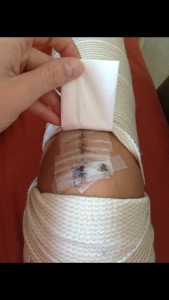Scientists Discover New Body Part
The tearing of the ACL in the human knee is one of the most common injuries experienced by athletes. Through activities which involve pivoting, such as basketball, soccer, and football, ACL tears are bound to happen at some point. The anterior cruciate ligament, otherwise abbreviated as the ACL, is one of the four major ligaments in the human knee allowing for medial rotation of the tibia. When the ligament tears, the knee no longer has the support it needs for planting and rotating.
Just one of many who have personally experienced this injury, Samantha Cohen described to me the reality of the recovery process by saying that, “After my surgery, I was on crutches for about a week and a half. A couple of days after my surgery I began PT 2-3 times a week for a couple of months. I had to work to get all of my muscle back in my leg because it was completely gone from not being able to move it. After about 2 months, I was able to take my brace off. I began running after about 4 months. It took approximately 7-8 months to feel one hundred percent.”
Although in minor tears the injury can be treated with therapy, most situations require surgery in order for the individual to begin rigorous physical activity again. Since ACL tears are among the most common in athletes, doctors treat more than 100,000 ACL tears in the United States alone every year. Athletes believe doctors are experts in fixing these problems, but even after surgery some patients have reported that they continue to feel pivot shifts in their knee after they have recovered from surgery.
In an age with all sorts of advanced medical techniques, one may think that doctors are familiar with every part of the body. However, through a recent discovery, two Belgian Physicians have proven this theory to be wrong. At the University Hospital Leuven in Belgium, Dr. Steven Claes and Professor Dr. Johan Bellemans have spent four years trying to solve the mystery of why patients continue to have pivoting problems with their knees after surgery. Using macroscopic dissection techniques on 41 cadaver knees, the Belgian duo came up with a hypothesis. According to their research, 97% of humans have something called an anterolateral ligament (ALL) in addition to their ACL, and pivot shifts stem from an injury to this previously unknown body part.
When I mentioned my findings to a family friend and Occupational Therapist Katie Montiero, I asked her if she thought that it was worth using time and energy to examine farther into these discoveries. Although she does not usually work with these kind of injuries, she told me that, “I think they should spend a lot of time and energy to continue researching this discovery. If they are able to look into this new cure for the ACL injury after it is treated and find out what connection the ALL really has with the ACL, than why not spread the word about it if the treatment can help millions of athletes get back to their sport after the injury”.
This discovery could lead to a major breakthrough in treating ACL injuries. According to Science Daily, Claes and Bellemans are hard at work figuring out surgical techniques to repair the ALL, but those results will only be ready in several years. Until then, their research can be found published in the “Journal of Anatomy”, which shows the new ligament was present in all but one of those 41 knees.
With this new discovery, people may begin to doubt whether or not professionals do know everything there is to know about the body and its functions. If the finding of the ALL was just discovered in our modern age, what else could we be missing? It may be worthwhile to put more effort into examining the human anatomy closer than ever before in order to put these questions to rest. Thorough observations and research must go into this before and more discoveries can be made, and more answers will only come in time.



